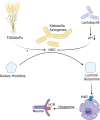Understanding neuroimmune interactions in disorders of gut-brain interaction: from functional to immune-mediated disorders
- PMID: 36657961
- PMCID: PMC10086308
- DOI: 10.1136/gutjnl-2020-320633
Understanding neuroimmune interactions in disorders of gut-brain interaction: from functional to immune-mediated disorders
Abstract
Functional gastrointestinal disorders-recently renamed into disorders of gut-brain interaction-such as irritable bowel syndrome and functional dyspepsia are highly prevalent conditions with bothersome abdominal symptoms in the absence of structural abnormalities. While traditionally considered as motility disorders or even psychosomatic conditions, our understanding of the pathophysiology has evolved significantly over the last two decades. Initial observations of subtle mucosal infiltration with immune cells, especially mast cells and eosinophils, are since recently being backed up by mechanistic evidence demonstrating increased release of nociceptive mediators by immune cells and the intestinal epithelium. These mediators can activate sensitised neurons leading to visceral hypersensitivity with bothersome symptoms. The interaction between immune activation and an impaired barrier function of the gut is most likely a bidirectional one with alterations in the microbiota, psychological stress and food components as upstream players in the pathophysiology. Only few immune-targeting treatments are currently available, but an improved understanding through a multidisciplinary scientific approach will hopefully identify novel, more precise treatment targets with ultimately better outcomes.
Keywords: FUNCTIONAL BOWEL DISORDER; FUNCTIONAL DYSPEPSIA; INTESTINAL MAST CELLS; IRRITABLE BOWEL SYNDROME; Intestinal eosinophils.
© Author(s) (or their employer(s)) 2023. Re-use permitted under CC BY-NC. No commercial re-use. See rights and permissions. Published by BMJ.
Conflict of interest statement
Competing interests: TV has received research grants from Danone and MyHealth; has served on the speaker bureau of Abbott, Biocodex, Dr. Falk Pharma, Menarini, MyHealth, Schwabe and Truvion, has provided scientific advice to Biocodex, BMS and Dr. Falk Pharma. PB and GB have no competing interests.
Figures






Similar articles
-
Therapeutic strategies for functional dyspepsia and irritable bowel syndrome based on pathophysiology.J Gastroenterol. 2015 Jun;50(6):601-13. doi: 10.1007/s00535-015-1076-x. Epub 2015 Apr 29. J Gastroenterol. 2015. PMID: 25917563 Review.
-
The role of mast cells in functional GI disorders.Gut. 2016 Jan;65(1):155-68. doi: 10.1136/gutjnl-2015-309151. Epub 2015 Jul 20. Gut. 2016. PMID: 26194403 Review.
-
Neuroimmune factors in functional gastrointestinal disorders: A focus on irritable bowel syndrome.Neurogastroenterol Motil. 2017 Jun;29(6). doi: 10.1111/nmo.13007. Epub 2016 Dec 27. Neurogastroenterol Motil. 2017. PMID: 28027594 Review.
-
Evidence that independent gut-to-brain and brain-to-gut pathways operate in the irritable bowel syndrome and functional dyspepsia: a 1-year population-based prospective study.Aliment Pharmacol Ther. 2016 Sep;44(6):592-600. doi: 10.1111/apt.13738. Epub 2016 Jul 22. Aliment Pharmacol Ther. 2016. PMID: 27444264
-
Functional gastrointestinal disorders: advances in understanding and management.Lancet. 2020 Nov 21;396(10263):1664-1674. doi: 10.1016/S0140-6736(20)32115-2. Epub 2020 Oct 10. Lancet. 2020. PMID: 33049221 Review.
Cited by
-
Duodenal microbiota dysbiosis in functional dyspepsia and its potential role of the duodenal microbiota in gut-brain axis interaction: a systematic review.Front Microbiol. 2024 Aug 6;15:1409280. doi: 10.3389/fmicb.2024.1409280. eCollection 2024. Front Microbiol. 2024. PMID: 39165566 Free PMC article.
-
A Comprehensive Review of Upper Gastrointestinal Symptom Management in Autoimmune Gastritis: Current Insights and Future Directions.Cureus. 2023 Aug 13;15(8):e43418. doi: 10.7759/cureus.43418. eCollection 2023 Aug. Cureus. 2023. PMID: 37706145 Free PMC article. Review.
-
Redefining Histological Cell Counts Using a Standardized Method: The Leuven Intestinal Counting Protocol.Clin Transl Gastroenterol. 2024 Jul 1;15(7):e00725. doi: 10.14309/ctg.0000000000000725. Clin Transl Gastroenterol. 2024. PMID: 38888240 Free PMC article.
-
Developmental impact of peripheral injury on neuroimmune signaling.Brain Behav Immun. 2023 Oct;113:156-165. doi: 10.1016/j.bbi.2023.07.002. Epub 2023 Jul 11. Brain Behav Immun. 2023. PMID: 37442302 Free PMC article. Review.
-
Abdominal Wall-targeted Myofascial Release Therapy in Pediatric Patients with Irritable Bowel Syndrome: A Feasibility and Acceptability Study.Int J Ther Massage Bodywork. 2024 Dec 12;17(4):27-42. doi: 10.3822/ijtmb.v17i4.1035. eCollection 2024 Dec. Int J Ther Massage Bodywork. 2024. PMID: 39669545 Free PMC article.
References
-
- Stanghellini V, Talley NJ, Chan F. Rome IV - Gastroduodenal Disorders. Gastroenterology 2016;150:1380–92. - PubMed
Publication types
MeSH terms
Grants and funding
LinkOut - more resources
Full Text Sources
Medical
